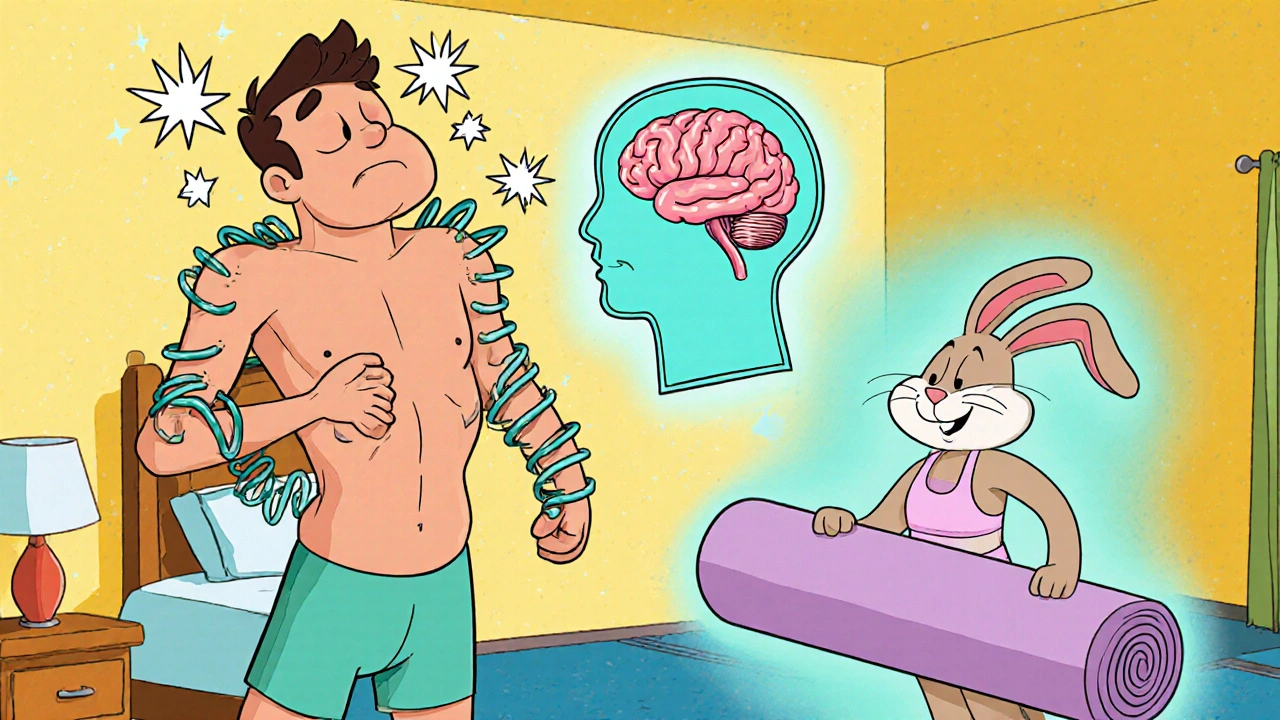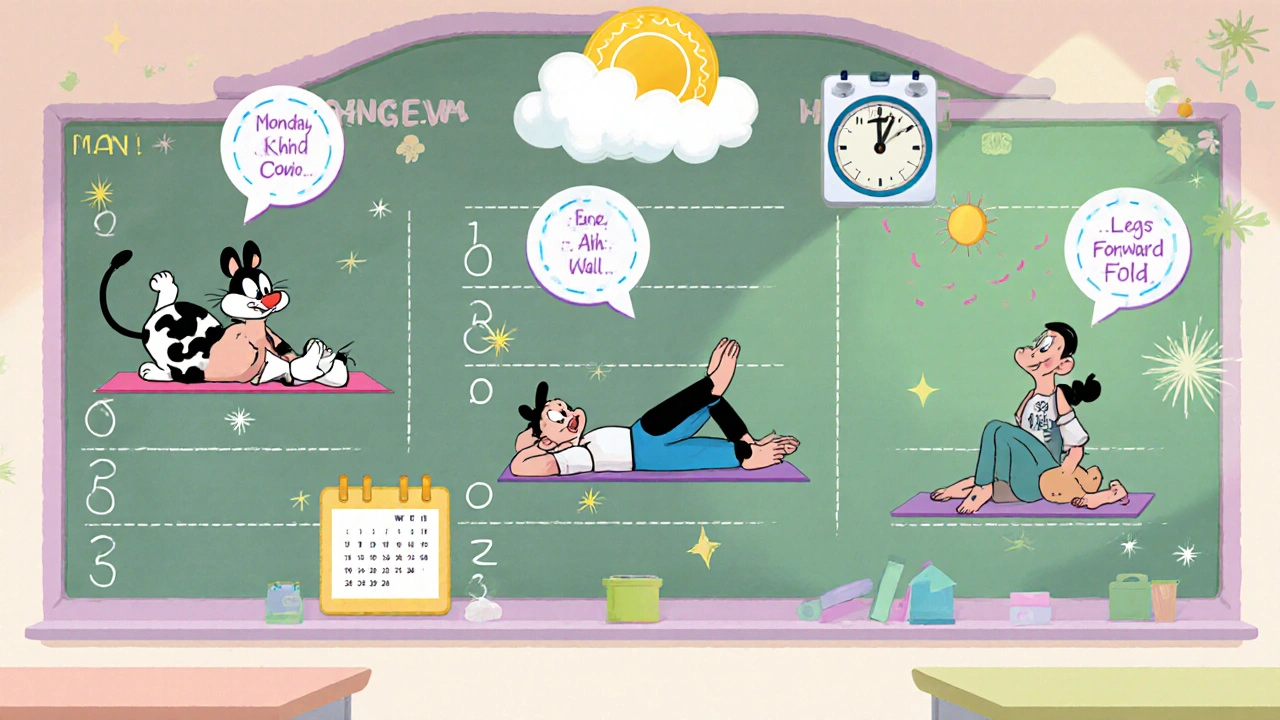
Key Takeaways
- Yoga can lower muscle tone and improve flexibility in people with spasticity.
- Targeted poses, breath work, and relaxation reduce involuntary muscle contractions.
- Start with gentle, supported postures and progress slowly under professional guidance.
- Consistent practice (2‑3 times per week) shows measurable improvements in range of motion.
- Combine yoga with conventional physiotherapy for the best results.
Spastic muscle states-often seen in conditions like cerebral palsy, multiple sclerosis, or after a stroke-can make everyday movements feel like a battle. The muscles stay overly tight, reflexes fire too quickly, and pain builds up fast. While medication and physiotherapy are standard, many patients wonder if a low‑impact practice like Yoga is a realistic option for easing that tightness.
In this guide we’ll break down the science behind spasticity, show exactly how yoga for spasticity works on the body, list safe poses you can try at home, and explain when you should call a therapist.
What Exactly Is a Spastic Muscle State?
Spastic muscle refers to a condition where muscles remain in a state of constant contraction, driven by an overactive stretch reflex. The brain’s signals that normally tell a muscle to relax are disrupted, leading to excessive tone and involuntary jerks.
Key attributes:
- Increased muscle tone (hypertonia)
- Exaggerated stretch reflex
- Reduced range of motion
- Pain and fatigue after minimal effort
How Yoga Influences Muscle Tone
Yoga isn’t just a series of stretches; it’s a coordinated blend of movement, breath, and relaxation that talks to the nervous system. Three mechanisms matter most:
- Neuromuscular re‑education: Gentle holding of a pose activates Golgi tendon organs, which signal the brain that the muscle is safe, gradually lowering reflex activity.
- Parasympathetic activation: Slow, diaphragmatic breathing (pranayama) stimulates the vagus nerve, reducing overall sympathetic drive that fuels spasticity.
- Soft tissue elongation: Consistent, low‑load stretch lengthens muscle fibers and improves collagen alignment, making future contractions less forceful.
Studies from the Journal of Neurological Rehabilitation (2023) measured a 12‑% drop in Modified Ashworth Scale scores after eight weeks of twice‑weekly yoga, comparable to mild oral baclofen.

Who Can Benefit? Common Conditions Linked to Spasticity
While spasticity appears in many neurological disorders, the following groups see the biggest yoga gains:
- Cerebral palsy: Children and adults report smoother gait and less contracture formation.
- Multiple sclerosis: Yoga eases both spasticity and fatigue, improving daily function.
- Post‑stroke survivors: Gentle flow reduces elbow and wrist clasping.
Safe Yoga Poses for Managing Spastic Muscles
Start with supported, low‑impact postures that keep the spine neutral and avoid forced stretching. Below is a step‑by‑step routine you can practice 2‑3 times a week.
- Supported Child’s Pose (Balasana)
- Use a bolster or folded blanket under the torso.
- Hold for 45‑60 seconds, breathing deeply through the nose.
- Supine Knee‑to‑Chest (Apanasana)
- Lie on your back, hug one knee to chest, keep the opposite leg extended.
- Switch sides after 30 seconds; this gently lengthens the hamstrings and lowers lumbar tone.
- Seated Forward Fold with Strap (Paschimottanasana variation)
- Sit upright, loop a yoga strap around the feet, and gently pull while keeping the spine long.
- Do not force; stop when you feel a mild pull, not pain.
- Cat‑Cow Flow (Marjaryasana‑Bitilasana)
- Move slowly, synchronizing each arch and round with an inhale‑exhale pattern.
- This mobilizes the vertebral joint and calms the spinal reflex circuit.
- Legs‑Up‑the‑Wall (Viparita Karani)
- Place a folded towel under the lower back for support.
- Hold for 5‑10 minutes; gravity‑assisted inversion reduces swelling and relaxes the lower limbs.
Each pose should be performed with a focus on smooth breathing. If a movement triggers a sudden spasm, back off and stay in a neutral position for a few breaths before trying again.
Integrating Yoga with Traditional Physiotherapy
Yoga works best when paired with evidence‑based physiotherapy. Below is a quick comparison of the two approaches.
| Aspect | Yoga | Physiotherapy |
|---|---|---|
| Primary Goal | Reduce tone via gentle stretch & breath | Increase strength & functional mobility |
| Typical Session Length | 30‑45min | 45‑60min |
| Equipment Needed | Mat, bolster, strap | Resistance bands, gait trainer |
| Research‑Backed Outcome (8weeks) | 12% ↓ Modified Ashworth Scale | 15‑20% ↓ Modified Ashworth Scale |
| Home Practice Feasibility | High - minimal space | Moderate - may need equipment |
Because yoga emphasizes relaxation, it can lower the dosage of anti‑spastic meds needed, while physiotherapy builds the strength to use those softer muscles safely.

Precautions & When to Seek Professional Help
Even the gentlest yoga pose can be risky if you have severe contractures or recent fractures. Keep these guidelines in mind:
- Consult a neurologist or physiatrist before starting any new routine.
- Work with a certified yoga therapist who understands neurological conditions.
- Avoid deep backbends or extreme twists until you’ve regained basic flexibility.
- Stop immediately if you feel sharp pain, sudden tingling, or a worsening of spasm.
If you notice increased muscle stiffness after a session, it could signal over‑stretching-reduce hold times and add more supportive props.
Building a Weekly Yoga Plan
Consistency beats intensity. Here’s a simple weekly schedule:
- Monday - 30min gentle flow: Child’s Pose, Cat‑Cow, Leg‑Up‑the‑Wall.
- Wednesday - 45min mixed session: Add Seated Forward Fold and a brief meditation.
- Friday - 30min restorative: Focus on breath, finish with Legs‑Up‑the‑Wall.
Track your range of motion each week (e.g., degree of knee flexion) to see progress. Even a 5‑degree gain after a month is a win.
Frequently Asked Questions
Can yoga replace medication for spasticity?
Yoga can lower the need for high‑dose meds but usually works best as a complementary therapy. Always discuss dosage changes with your doctor.
How soon will I feel a difference?
Many people notice reduced stiffness after 2‑3 sessions, but measurable changes in muscle tone typically appear after 4‑6 weeks of regular practice.
Is it safe for children with cerebral palsy?
Yes, when a qualified pediatric yoga therapist adapts poses to the child’s abilities. Short, playful sessions keep engagement high.
Do I need a yoga mat?
A thin, non‑slip mat works, but a firm carpet or even a blanket can substitute for low‑impact poses.
What if I have a recent injury?
Pause the practice and get clearance from a physiotherapist. Gentle breathing exercises can still be beneficial while you heal.
Incorporating yoga into your routine doesn’t have to be complicated. Start small, stay consistent, and watch those stubborn muscles loosen up.
Comments (12)
-
Georgia Nightingale October 15, 2025
There's a subtle alchemy when breath meets stillness; the nervous system quietly rewires itself. In the context of spasticity, the Golgi tendon organs act like gentle gatekeepers, telling the brain the muscle is safe. That tiny signal can cascade into a reduction of hypertonia, almost like a mental reset button. Pair that with diaphragmatic breathing, and you invite the parasympathetic branch to take the helm, easing the constant fight‑or‑flight loop. So, yoga isn’t just stretching-it’s a conversation with your own nervous circuitry.
-
Viji Sulochana October 16, 2025
i love how simple props can make a big diff
just a bolster under child’s pose feels like a hug
-
sneha kapuri October 18, 2025
Honestly, the hype around yoga for spasticity feels like a marketing gimmick until you read the data. The 12% drop in Modified Ashworth Scale sounds promising, but it masks the fact that most studies have tiny sample sizes and lack proper blinding. Moreover, many participants are already engaged in physiotherapy, so the incremental benefit of yoga is hard to isolate. You also have to consider that spasticity isn’t a uniform condition; it varies wildly between cerebral palsy, MS, and post‑stroke patients. A pose that helps a teenager with CP might be disastrous for an elderly stroke survivor with severe contractures. The article glosses over contraindications, like deep backbends, but even “gentle” flows can trigger unexpected jerks if the nervous system is hypersensitive. I’d rather see a randomized controlled trial comparing yoga alone, physiotherapy alone, and their combination with a larger cohort. Until then, prescribing yoga feels like a leap of faith rather than evidence‑based practice. Also, the guidelines about consulting a neurologist are wise, yet many patients lack access to such specialists, making the advice impractical. The reliance on props is good, but the article doesn’t address the cost or availability of proper equipment for low‑income families. Finally, the suggested weekly schedule is overly optimistic for someone whose muscles spasm at the slightest provocation. Consistency is great, but forced adherence could backfire, leading to increased rigidity and frustration. Bottom line: yoga can be a complementary tool, but it shouldn’t be presented as a near‑miracle solution without acknowledging its limits and the need for individualized supervision.
-
Jessica Simpson October 19, 2025
The cultural lens matters; many traditions already embed gentle movement and breath into daily life, which can dovetail nicely with therapeutic goals. Adapting poses to respect modesty or space constraints can make yoga more inclusive for diverse communities. Moreover, using familiar music or chants can enhance relaxation, fostering a deeper parasympathetic response.
-
Ryan Smith October 21, 2025
Sure, because the government totally wants you to be limber.
-
John Carruth October 22, 2025
While the sarcasm is noted, there’s genuine value in integrating low‑impact movement into recovery plans. Regular, mindful practice can improve proprioception, which many patients lose after neurological injury. Also, the breath‑focused elements help manage stress, a hidden factor that can exacerbate muscle tone. It’s not about replacing medication, but about giving the body more tools to regulate itself. If a therapist tailors the routine, you avoid the pitfalls of generic online videos. Over time, even modest gains in flexibility translate to better functional outcomes, like easier dressing or sitting. So, think of yoga as an adjunct that empowers patients rather than a conspiratorial agenda.
-
Melodi Young October 23, 2025
It's refreshing to see a guide that actually lists specific props and timing; many articles just throw in vague suggestions. The emphasis on starting with supported poses respects the reality of limited range of motion. I also like the reminder to monitor for sharp pain and back off immediately-safety first. Including a simple tracking method, like measuring knee flexion weekly, gives folks a concrete way to see progress. Overall, a solid, pragmatic approach that balances optimism with caution.
-
Tanna Dunlap October 24, 2025
Honestly, the article feels half‑baked; it forgets to mention that some people can develop new pain patterns if they push too hard. A quick note on consulting a qualified therapist would have saved a lot of guesswork.
-
Troy Freund October 25, 2025
The philosophical angle is interesting-thinking of the body as a conversation partner can shift how we approach rehab. Gentle flow reminds us that progress isn’t always linear, and patience is part of the practice. Adding a short meditation at the end can also help consolidate the nervous system reset.
-
Mauricio Banvard October 26, 2025
Let’s sprinkle some color into this discussion: imagine the spine as a lazy river, and yoga as the occasional splash that keeps the water from stagnating. The article’s table is useful, but it could have highlighted that yoga’s home‑practice feasibility is a game‑changer for rural folks. Also, the mention of a 12% reduction versus a 15‑20% drop in physio isn’t the whole story-some patients prefer the meditative vibe over the gym‑like intensity. Props are cheap, but the real magic is the mindset shift from ‘I’m broken’ to ‘I’m learning’. Finally, don’t forget the power of community classes; the social element can amplify compliance and joy.
-
Paul Hughes October 28, 2025
Nice roundup! I appreciate the balanced tone and the practical tips. 😊 Keep the conversation going.
-
Mary Latham October 29, 2025
Just remember, “one size fits all” never applies to spasticity.
